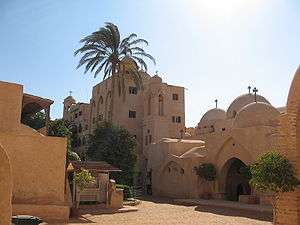Please tell us which country and city you'd like to see the weather in.

Wadi El Natrun
Wadi El Natrun (Arabic for "Natron Valley"; Coptic: Ϣⲓϩⲏⲧ Šihēt "Measure of the Hearts", Greek: Σκῆτις or Σκήτη) is a valley located in Beheira Governorate, Egypt, including a town with the same name. The name refers to the presence of eight different lakes in the region that produce natron salt.
In Christian literature it is usually known as Scetis (or Skete; Σκήτις, Σκέτη in Ancient Greek) and is one of the three early Christian monastic centers located in the desert of the northwestern Nile Delta. The other two monastic centers are Nitria and Kellia. These three centers are often easily confused and sometimes referred to as a single place (such as "Nitria" or "Nitrian Desert"), but the locales are distinct, though geographically close together and with interrelated histories. Scetis, now called Wadi El Natrun, is best known today because its ancient monasteries remain in use, unlike Nitria and Kellia which have only archaeological remains.
The Nitrian Desert is sometimes used to mean the entire region where the monasteries are located. It can also more specifically refer to the immediate area around Nitria and Kellia, with the region around Wadi El Natrun then more specifically called the Scetis Desert. (The word Σκήτη has been adopted in Greek language monastic usage as an isolated monastic cell that is not in a convent, whereas Kellia (Κελλία (sing. Κελλίον from Latin 'cella') is a monastic cell in a convent.)

Wadi
Wadi (Arabic: وادي"wādī) "Vadi" (Hebrew: ואדי "vādī)" is the Arabic and Hebrew term traditionally referring to a valley. In some instances, it may refer to a dry (ephemeral) riverbed that contains water only during times of heavy rain or simply an intermittent stream.
Etymology
The term wādī is very widely found in Arabic toponyms.
Some Spanish toponyms are derived from Andalusian Arabic where wādī was used to mean a permanent river, for example: Guadalcanal from wādī al-Qanal = "river of refreshment stalls", Guadalajara from wādī al-hidjārah = "river of stones", or Guadalquivir from al-wādī al-kabīr = "the great river". Seasonal streams, frequent in south-east Spain, are called ramblas instead.
In the Maghreb, the term wadi (wad in Maghrebi Arabic, sometimes transcribed Oued) is applied to all rivers including regular ones.
General morphology and processes
Wadis are located on the gently sloping, nearly flat parts of deserts; commonly they begin on the distal portions of fans and extend to inland sabkhas or playas. In basin and range topography, wadis trend along basin axes at the terminus of fans. Permanent channels do not exist, due to lack of continual water flow. Wadi show braided stream patterns because of the deficiency of water and the abundance of sediments. Water percolates down into the stream bed causing abrupt loss in energy and resulting vast deposition. Wadis may develop dams of sediment which results in change of stream patterns in the next flash flood. :)

Wadi, Karnataka
Wadi (ವಾಡಿ) is a census town in Gulbarga district in the Indian state of Karnataka. The Wadi Junction railway station is an important railway junction on the Indian railways. Trains from the metro cities of Mumbai, Bangalore,Hyderabad and Chennai pass through this town. Wadi is home to two cement plants of Associated Cement Company Limited ( ACC ) . The ACC has two cement plants of capacity 2.11 and 2.6 million tonnes per annum (mtpa).The cement plants are some of the largest in the country. Wadi is also famous for its Limestone mines. The main source of income is ACC, Railway's and Working in Lime Stone Mines. The growth of cement plants(ACC) and railways in the region has attracted people from diverse regions and cultures. Gulbarga, which is around 37 km from Wadi is a major educational centre which houses many engineering, medical, management and dental colleges.
Geography
Wadi is located at 17°04′N 76°59′E / 17.07°N 76.98°E / 17.07; 76.98. It has an average elevation of 411 metres (1348 feet).

Wadi, Maharashtra
Wadi is a census town in Nagpur district in the Indian state of Maharashtra.
Demographics
As of 2001 India census, Wadi had a population of 40,147. Males constitute 53% of the population and females 47%. Wadi has an average literacy rate of 78%, higher than the national average of 59.5%: male literacy is 82%, and female literacy is 74%. In Wadi, 14% of the population is under 6 years of age.
Other Features
Wadi is generally a place where all the godowns and all the warehouses are found. Especially at main area can see marketplace, godowns for verious medicines, cosmetics and transportation. It has international highway no.6 (asian highway 46) known as amravati road.
References
Radio Stations - Wādi
SEARCH FOR RADIOS
Podcasts:

-
by Die Fantastischen Vier
Wie Die Anderen
by: Die Fantastischen Vierihr seid wie die anderen und die anderen sind wie ihr
